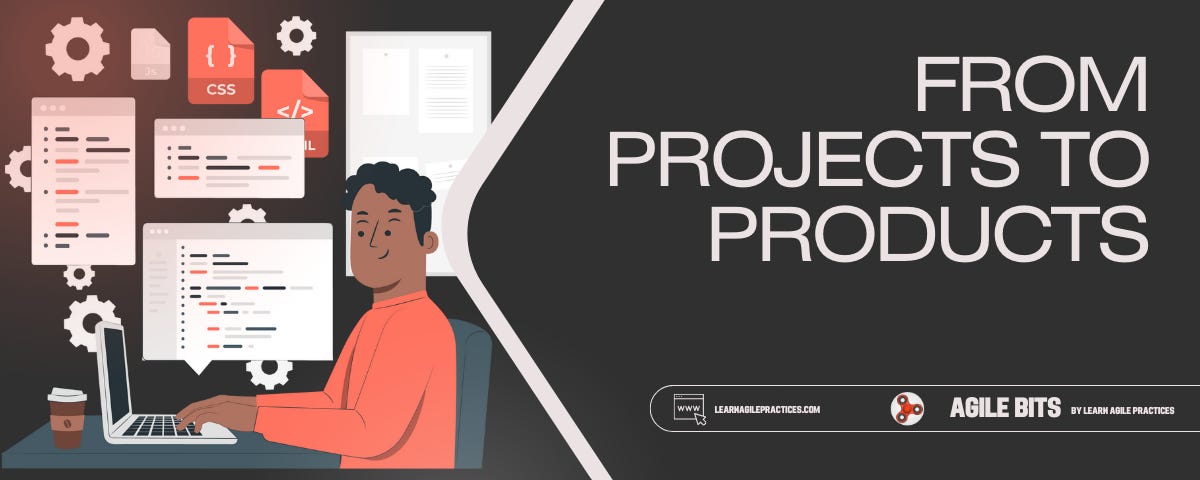From Projects to Products
The way we approach software development has a huge impact on its success. In most cases, business tend to treat software initiatives as projects, but this is not a good idea.
Hello, developers! 🚀
Welcome back to the Learn Agile Practices newsletter, your weekly dose of insights to power up your software development journey through Agile Technical Practices and Methodologies!
Before starting, I quickly remind you that my brand new Test-Driven Development 101 5-day Email Course is available: it is the introduction to TDD I wish I had when I started learning it, so I think you will find it very useful!
As a subscriber to my newsletter, you can have it with a 10EUR discount! 👇
Now, let's dive into today's micro-topic!
In short
📈 Approaching software as a project often leads to rushed, rigid outcomes because projects are temporary and focused on fixed deliverables. Software is a dynamic entity that requires ongoing adaptation to meet changing user needs, making the project model a poor fit.
🚀 A product-oriented approach treats software as an evolving asset. Teams focus on continuous improvement, learning, and incremental funding, allowing for flexibility and sustained customer value. Stable, long-term teams gain deep domain expertise, enhancing decision-making and adaptability.
🛠️ A product culture is customer-centric, agile, and supports a sustainable development pace. It emphasizes ongoing learning and avoids the pitfalls of fixed plans, making it better aligned with the unpredictable nature of software. By focusing on continuous value, this mindset leads to higher quality and greater user satisfaction over time.
Projects Are Not Well-Suited for Software
The way we approach software development has a huge impact on its success. In most cases, business tend to treat software initiatives as projects—fixed endeavors with a definitive start, end, and a checklist of deliverables. However, software is rarely, if ever, "finished." It is a living, evolving entity. To reflect this reality, we need to shift from project thinking to a product mindset. Let’s explore why.
Projects, by definition, are temporary. They have a set budget, fixed scope, and strict deadlines. In software development, this often means a rush to meet predefined goals before time or money runs out. Success is frequently measured by how closely we stuck to the original plan rather than by the value delivered to the customer.
This rigid approach is not a good match with software development.
Why? Because software is inherently complex and dynamic. User requirements, market conditions, and technology itself change rapidly. The features we thought were important six months ago might no longer make sense. Project thinking often traps teams into delivering outdated or suboptimal solutions, simply because it’s "what the plan says".
The project model also encourages a temporary, transient team structure. Once a project ends, the team disbands, taking with them crucial domain knowledge that has been built up over time. This makes future changes more challenging and costly, as new teams have to rediscover old knowledge and context.
Software Is a Product by Its Own Nature
In reality, software behaves much more like a product than a project. Unlike projects, products have a lifecycle that doesn’t end until the product is decommissioned. They are built to last, grow, and evolve. Software products must continuously adapt to new user feedback, emerging needs, and technological advances. A custom system is never truly "done"—there is always room for improvement, optimization, and innovation.
A product-oriented mindset embraces this reality by allowing scope and priorities to change based on ongoing learning and feedback. The focus shifts from adhering to a static plan to delivering continuous value over time. Funding is typically incremental, reflecting the evolving nature of the product rather than front-loading all investments. This incremental funding approach signals that we are open to pivoting and adapting as new insights emerge.
Moreover, the product mindset relies on stable, cross-functional teams that stay with the product throughout its lifecycle. These teams build deep domain knowledge and become experts in the product and its users. They can anticipate needs, solve problems faster, and make better decisions because they know the product intimately.
The Benefits of a Product Culture
Shifting to a product-focused culture brings several significant benefits:
Customer-Centric Development: A product mindset emphasizes delivering value to customers continuously, rather than delivering a predefined set of features. This approach encourages ongoing feedback loops with users, allowing teams to prioritize features that provide the most impact and remove those that no longer add value.
Increased Agility and Adaptability: With a focus on iterative, incremental delivery, product teams can adapt to changing market conditions and user needs much faster than project teams. They are not bound by the constraints of a rigid project plan and can pivot easily when new information comes to light.
Improved Team Cohesion and Expertise: In a product culture, teams remain stable over time, building up deep product knowledge. This reduces the overhead of onboarding new team members repeatedly and allows for faster, more informed decision-making. The team becomes an asset to the product, carrying forward valuable insights and learnings.
Sustainable Development Pace: Projects often have an intense push towards the end to meet deadlines, which can lead to burnout and technical debt. In a product-oriented approach, the pace is more sustainable, focusing on long-term health and continuous improvement. There’s no “end” rush—just a steady cadence of delivering value.
Embrace the Product Mindset
In software development, adopting a product mindset aligns better with the realities of modern, evolving systems. Products grow, adapt, and continuously deliver value, while projects often end prematurely, leaving potential value on the table. A product focus fosters a culture of learning, experimentation, and continuous improvement, which are crucial for software that needs to keep up with user expectations and a changing market.
Until next time, happy coding! 🤓👩💻👨💻


